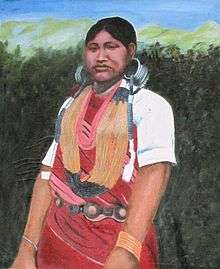Hill Miri dialect
Nyishi (Kamle) or Sarak is a Tani language of India. It is spoken in Arunachal Pradesh by an estimated 9,000 people of the Nyishi tribe.[2] It appears to be a dialect of the Nishi language.[3]

| Nyishi (Kamle) | |
|---|---|
| Sarak | |
| Region | Arunachal Pradesh |
| Ethnicity | Nyishi (Kamle) people |
Native speakers | (undated figure of 10,100)[1] |
Sino-Tibetan
| |
| Language codes | |
| ISO 639-3 | None (mis)Individual code: mrg – (included under Plains Miri) |
| Glottolog | None |
Description
Nyishi(muri-mugli) is a member of the Tani branch of the Sino-Tibetan languages and is considered a dialect of the Nishi language. It is spoken by 9,000 people in the northern regions of India by the Nyishi people of Kamle.[4] It is threatened because the younger generation is slowly breaking away from their people's traditions and language.[5][6] Many audio books of gospel narratives in the Nyishi language of Kamle have been collected.
History of scholarship
George Abraham Grierson, in his survey of India regarding its linguistics, researched the Nyishi language and published a record over a century ago.
Phonology
Consonants
The following table includes an inventory of Nyishi (Kamle) consonants.[7]
| Labial | Alveolar | Post- alveolar |
Velar | Glottal | ||
|---|---|---|---|---|---|---|
| Nasal | m | n | ɲ[8] | ŋ | ||
| Stop | voiceless | p | t | c[9] | k | |
| voiced | b | d | ɟ[10] | ɡ | ||
| Fricative | s | ʃ | h | |||
| Approximant | w | l | j | |||
| Trill? | r | |||||
Vowels are front /i, e/, central /ɨ, ʉ, ə, a/,[11] and back /u, o/. Vowels occur long and short.
Grammar
The basic Nyishi (Kamle) grammar and basic word order are like those of related Sino-Tibetan languages, similar to that of Nishi.
Numerals
| Nyishi (Kamle) | |
|---|---|
| 1 | aken |
| 2 | eñi |
| 3 | oum |
| 4 | epi |
| 5 | ango/angngo |
| 6 | ake |
| 7 | kenne |
| 8 | pine |
| 9 | kora |
| 10 | íri |
Pronouns
Personal
| Singular | Plural | |
| 1st person | ngo | ngu-lu |
| 2nd person | no | nu-lu |
| 3rd person | bu, bú | bu-lu, bú-lu |
References
- Mising at Ethnologue (15th ed., 2005)
- Moseley, Christopher (2007). Encyclopedia of the world's endangered languages. Routledge. p. 298. ISBN 978-0-7007-1197-0. Retrieved 1 April 2012.
- Post, Mark W. (2013). Defoliating the Tani Stammbaum: An exercise in areal linguistics. Paper presented at the 13th Himalayan Languages Symposium. Canberra, Australian National University, Aug 9.
- Audio
- Nabam Tadar Rikam, "Emerging religious Identities of Arunachal Pradesh", Mittal Publications, 2005
- Ju Namkung, "Phonological inventories of Tibeto-burman languages", Center for Southeast Asia Studies, University of California, 1996
- Value unclear, perhaps [nʲ]?
- Value unclear, perhaps [t͡ʃ]?
- Value unclear, perhaps [d͡ʒ]?
- Transcribed ⟨ɯ, y, ɤ, a⟩ in Namkung
Further reading
- Ivan Martin Simon, "Hill Miri language guide", Govt. of Arunachal Pradesh, 1976
- Matthew S. Dryer, "Word order in Tibeto-burman languages" Linguistics of the Tibeto-Burman Area, 2008
- Shri Aduk Tayeng, "Nishi Phrase book", Arunachal Pradesh, 1990
- P. T. Abraham, "A Grammar of Nyishi Language", 2005
- S. N. Goswami, "Nishing ( Bangni) Language Guide", 1995